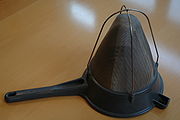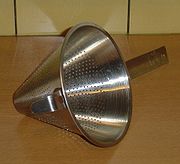.gif)
Chinoise (utensil)
Encyclopedia


Sieve
A sieve, or sifter, separates wanted elements from unwanted material using a woven screen such as a mesh or net. However, in cooking, especially with flour, a sifter is used to aerate the substance, among other things. A strainer is a type of sieve typically used to separate a solid from a liquid...
with an extremely fine mesh. It is used to strain custards, purees, soups, and sauces, producing a very smooth texture. It can also be used to dust pastry
Pastry
Pastry is the name given to various kinds of baked products made from ingredients such as flour, sugar, milk, butter, shortening, baking powder and/or eggs. Small cakes, tarts and other sweet baked products are called "pastries."...
with a fine layer of powdered sugar.
Chinoise is pronounced shin'-wahz. Chinois is pronounced shin'-wah.
Both names, chinoise and chinois, are loanword
Loanword
A loanword is a word borrowed from a donor language and incorporated into a recipient language. By contrast, a calque or loan translation is a related concept where the meaning or idiom is borrowed rather than the lexical item itself. The word loanword is itself a calque of the German Lehnwort,...
s from French
French language
French is a Romance language spoken as a first language in France, the Romandy region in Switzerland, Wallonia and Brussels in Belgium, Monaco, the regions of Quebec and Acadia in Canada, and by various communities elsewhere. Second-language speakers of French are distributed throughout many parts...
. The name chinoise comes from the feminine
Grammatical gender
Grammatical gender is defined linguistically as a system of classes of nouns which trigger specific types of inflections in associated words, such as adjectives, verbs and others. For a system of noun classes to be a gender system, every noun must belong to one of the classes and there should be...
form of the French adjective meaning Chinese
China
Chinese civilization may refer to:* China for more general discussion of the country.* Chinese culture* Greater China, the transnational community of ethnic Chinese.* History of China* Sinosphere, the area historically affected by Chinese culture...
. The alternate name chinois comes from the masculine form and is the name of this utensil in French.
A related but far less expensive utensil, with a related name, is the China cap, a reference to the conical Asian hats common in China. It is a conical strainer of perforated metal with much larger holes than a chinoise. A China cap is used to remove seeds and other coarse matter from liquids and soft foods, but does not produce a very smooth texture.
Both the chinoise and the China cap often are used with a matching wooden cone with a handle. With its tip placed in the bottom of the strainer, the cone is moved against the sides of the strainer to work soft food through it. A China cap, used with this dowel, functions similar to a food mill
Food mill
A food mill is a food preparation utensil for mashing and sieving soft foods...
, tamis
Tamis
A tamis is a kitchen utensil, shaped somewhat like a snare drum, that acts as a strainer, grater, or food mill. A tamis has a cylindrical edge, made of metal or wood, that supports a disc of fine metal, nylon, or horsehair mesh. To use one, the cook places the tamis above a bowl and adds the...
, or colander
Colander
A colander is a bowl-shaped kitchen utensil with holes in it used for draining food such as pasta or rice.The perforated nature of the colander allows liquid to drain through while retaining the solids inside...
used with a muddler
Muddler
A muddler is a bartender's tool, used like a pestle to mash — or muddle — fruits, herbs, and/or spices in the bottom of a glass to release their flavor....
. A chinoise generally is too fine for this purpose.

